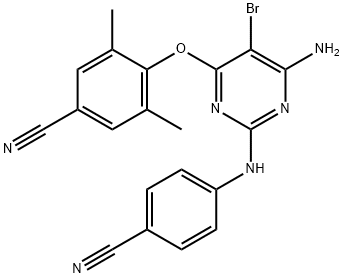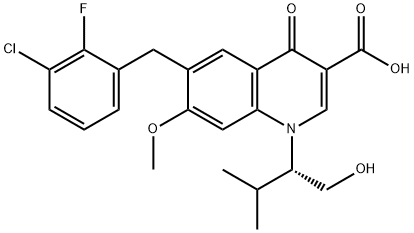Etravirine (TMC125) , ≥95% , 269055-15-4
CAS NO.:269055-15-4
Empirical Formula: C20H15BrN6O
Molecular Weight: 435.28
MDL number: MFCD09837879
EINECS: 682-331-6
| Pack Size | Price | Stock | Quantity |
| 5MG | RMB125.60 | In Stock |
|
| 25MG | RMB407.20 | In Stock |
|
| 100MG | RMB772.80 | In Stock |
|
| 1g | RMB1574.40 | In Stock |
|
| others | Enquire |
PRODUCT Properties
| Melting point: | .265°C (dec.) |
| Boiling point: | 637.4±65.0 °C(Predicted) |
| Density | 1.439 g/cm3 |
| storage temp. | Keep in dark place,Inert atmosphere,Store in freezer, under -20°C |
| solubility | DMSO (Slightly), Methanol (Slightly, Heated, Sonicated) |
| form | Solid |
| pka | 1.23±0.10(Predicted) |
| color | White to Off-White |
Description and Uses
Etravirine is a second-generation NNRTI. It is indicated for use in
combination with other antiretroviral agents for treating HIV-1 infection in
treatment-experienced adult patients who have evidence of viral replication and HIV-1 strains resistant to the currently available NNRTIs and
other antiretroviral agents. The NNRTIs, along with nucleoside/nucleotide reverse transcriptase inhibitors (NRTIs/NtRTIs), are important
components of the combination regimens currently used to treat HIV-1
infection. The NRTIs/NtRTIs act by competing with the natural nucleotide
substrates of reverse transcriptase for incorporation into viral DNA
and subsequent chain termination. By contrast, the NNRTIs bind to an
allosteric site of the enzyme and disrupt the DNA polymerase function by
inducing conformational changes to the catalytic site. The allosteric
binding nature of NNRTIs generally results in improved safety profile
since there is no known human homolog for the drug-binding site of
the enzyme.
As with other NNRTIs, etravirine has
many drug–drug interactions. It is a substrate of CYP3A4, CYP2C9,
and CYP2C19, an inducer of 3A4, and an inhibitor of 2C9 and 2C19.
Caution should be used with co-administration of inducers, inhibitors, or
substrates of these enzymes. Etravirine can be synthesized starting from
5-bromo-2,4,6-trichloropyrimidine through three successive nucleophilic
substitution reactions. Initial displacement with 4-aminobenzonitrile using
Hu¨nig’s base, followed by reaction with sodium salt of 4-hydroxy-3,5-
dimethylbenzonitrile, and subsequent ammonolysis reaction with ammonia in dioxane under pressure affords etravirine.
.
Etravirine is a novel HIV reverse transcriptase inhibitor useful in treatment of HIV infection.
Safety
| Symbol(GHS) |  GHS09 |
| Signal word | Warning |
| Hazard statements | H410 |
| Precautionary statements | P273-P391-P501 |






